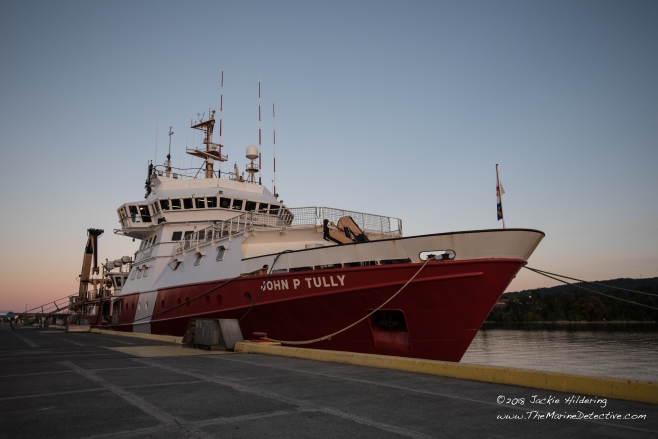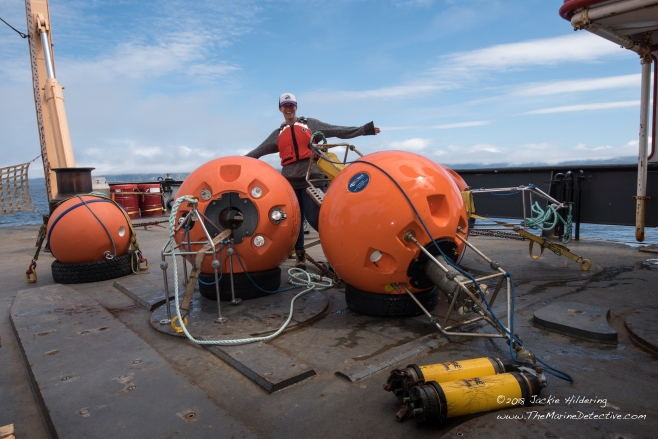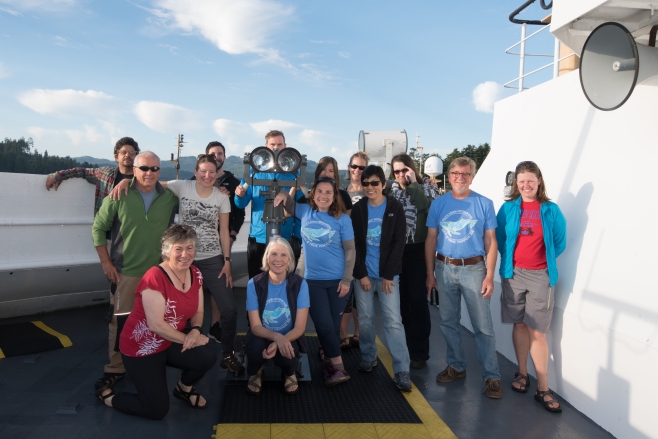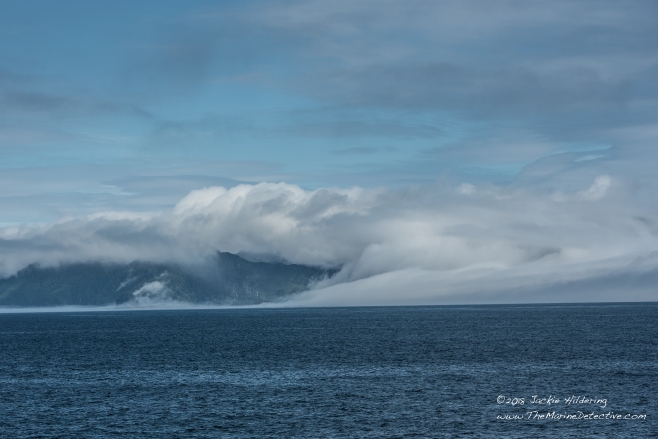PRISMM – survey to estimate distribution and abundance of marine megafauna off British Columbia
[Update on the Marine Mammal Provisions Rule: Article by CBC on 2021-12-01: See this link re. “In 2023, all seafood entering U.S. will have to show it was harvested with American-style protections.”]

PRISMM = the Pacific Region International Survey of Marine Megafauna.
Yes, I now have a t-shirt with “marine megafauna” on it which I consider a measure of a very happy and fortunate life. I was a spotter on PRISMM for two weeks. Colleagues were aboard for up to six consecutive weeks.

“Scientists board the CCGS John P. Tully at the Institute of Ocean Sciences. July 3, 2018”. Photo by Darren Stone, Times Colonist / Vancouver Sun. Source: Vancouver Sun.
The survey, led by Fisheries and Oceans Canada’s Cetacean Research Program, is aimed at determining the distribution and abundance of marine mammal’s in Canadian Pacific Waters. It involves ten weeks of surveying and two research vessels (two weeks overlapping between the two vessels).
Vessel #1. Now complete: Six weeks (July 3rd to August 13th) were surveyed from the CCGS John P.Tully (69 m), covering more than 6,000 km of BC’s offshore waters. In addition to a visual survey effort, an acoustic array was towed 24 hours a day to allow for the detection of deep diving cetaceans such as Sperm Whales and species of beaked whales and to provide detection of additional species when sighting conditions were poor.

Vessel 2. Ongoing: Four weeks (August 6th to September 6th) are being surveyed from the CCGS Tanu (51m long). These weeks will focus on BC’s coastal waters.

The maps below show the area covered by the Tully – from the west coast of Vancouver Island and Haida Gwaii to 200-nautical-miles (370 km) offshore (to the edge of Canada’s exclusive economic zone). The Tanu is covering the waters on the inside of Haida Gwaii and Vancouver Island.

The lines show all the transects to be systematically covered by survey effort from the Tully i.e. the vessel travelled each of these lines to allow visual and acoustic survey effort.

Photo by Robin Abernethy, DFO, shows what area had been covered about five weeks into the PRISMM survey. Every dot represents a sighting.
Detail about the PRISMM Survey from Fisheries and Oceans Canada’s website.
“Surveys of this magnitude have been conducted before by DFO in Atlantic Canada and the Central Arctic, but not in Canadian Pacific waters . . . The objective is to obtain data for as many cetacean species (e.g. whales, dolphins, and porpoises) as possible, as well as other marine species (seals and sea lions, sharks, sea turtles). [Hence “marine megafauna” as not all species are marine mammals.] Important research identified for these species include the assessment of population status, abundance trends and seasonal distribution. The emphasis will be on estimating abundance of marine mammal populations, which requires systematic surveys of all waters off British Columbia. However, this survey also provides a chance to refine our knowledge of the critical habitat of species listed under Canada’s Species at Risk Act (SARA), and for observation of species not listed under SARA, on which there has been less research effort in the past.”

Mola mola were among the marine megafauna surveyed. Photo taken during first two weeks of PRISMM.
This is not the first line transect survey conducted by the Cetacean Research Program off British Columbia’s coast. For many years, surveys have been conducted for two weeks in spring and two weeks in summer. It is also important to acknowledge that the Raincoast Conservation Foundation conducted surveys of coastal BC waters (the area being covered by Tanu during PRISMM) in 2004, 2005, 2007 and 2008 publishing much-valued abundance estimates for Harbour and Dall’s Porpoises, Pacific White-Sided Dolphins, Humpback, Minke and Fin Whales and contributing to the knowledge of line transect survey methodology.
The catalyst for the more extensive and systematic PRISMM line transect survey is an American regulation, the Marine Mammal Import Provisions Rule, that went into effect on January 1st, 2017 (with a 5-year grace period). To comply with this regulation by January 1st, 2022, countries importing seafood into the United States must be able to prove their fisheries monitor and limit marine mammal bycatch with the same standards as U.S. fisheries are required to do under the Marine Mammal Protection Act. Reportedly, such extensive surveys will be conducted every eight years (Source: Vancouver Sun).
In order to allow for the best possible abundance and distribution estimates, it is necessary to adhere to the line transects, consistent speed, and further protocols.Thereby, PRISMM did not involve some of the research objectives of past surveys where a smaller vessel is launched to achieve DNA sampling, identification of individual whales, and prey sampling.

Surveying. Chief Scientist Linda Nichol on “big eyes” and Hitomi Kimura on “little eyes”. Team member Caroline Fox surveying birds for Environment Canada.

Spotters relay sightings to the data recorder. Here, much bespectacled Bruce Paterson is on shift.
In addition to the survey effort, moored acoustic recorders were retrieved and deployed during PRISMM. These Autonomous Multichannel Acoustic Recorders (AMARs) are moored deep below the surface (up to ~2,400m) to passively monitor for cetacean vocals (they do not send out any sound). They need to be retrieved to get the recorded data, allowing for acoustic detection of cetaceans, and to have their batteries replaced so they can be repositioned. The retrieval of AMARs is a thing of wonder. The recorder with its buoy is released from the mooring when it receives a signal from the surface (i.e. has an acoustic release). You can imagine how much attention is paid to where the boat is positioned and how intently we are all waiting, looking for the device to surface.

An AMAR surfaces with the Tully deck crew ready to bring it aboard.

Bringing an AMAR on deck. Yellow devices contain the acoustic recorders.

Four AMARs were successfully retrieved in the first two weeks of PRISMM. Here with DFO Research Technician and friend, Robin Abernethy.
Marine megafauna sighted to date include:
- Blue Whales (endangered)
- Sei Whales (endangered)
- Fin Whales (threatened)
- Humpback Whales (of special concern)
- Grey Whales (of special concern however the Committee on the Status of Endangered Wildlife in Canada has recommended three populations be recognized of which two be protected as endangered populations)
- Minke Whales
- Sperm Whales
- Killer Whales (multiple ecotypes, threatened and endangered)
- Short-Finned Pilot Whales
- Risso’s Dolphins
- Cuvier’s Beaked Whales
- Baird’s Beaked Whales
- Pacific White-Sided Dolphins
- Northern Right Whale Dolphins
- Dall’s Porpoises
- Harbour Porpoises (of special concern)
- Northern Elephant Seals
- Steller Sea Lions (of special concern)
- Pacific Harbour Seals
- Northern Fur Seals
- Sea Otters (of special concern)
- Mola mola
- Blue Sharks
The rarest of the rare have not been sighted to date on PRISMM:
- North Pacific Right Whale (endangered)
- Basking Shark (endangered)
- Leatherback Turtle (endangered)
Humans involved in PRISMM:

Tully PRISMM Science crew July 3 to July 17: Back row left to right: Thomas Norris, Nicholas Riddoch, Kai Meyer, Elise Keppel, Robin Abernethy, Caroline Fox. Middle row left to right: Bruce Paterson, Jacklyn Barrs, Elizabeth Kusel, HItomi Kimura, John Ford, Ali Bowker. Kneeling in front left to right: your truly and Linda Nichol (Chief Scientist).

Same crew with less serious poses. Those with the head phones are the acoustics team. Photo: Sheena Majewski.

Tully PRISMM science crew July 17 to August 13. Yes, there may be a “Life Aquatic” theme here. Back row from left to right: Bruce Paterson, Erika Reigh Holland, Lisa Spaven, Thomas Doniol Valcroze (Chief Scientist), Wendy Szaniszlo, Christie McMillan, Kai Meyer, Robin Abernethy, Pina Gruden. Front row from left to right: Sheena Majewski, Karen Giouard, Kyla Graham, Elizabeth Kusel, Nicholas Riddoch.

Tanu PRISMM Science crew August 6 to 15. Back row from left to right: Nicole Koshure, Ashley Kling, Caroline Fox, Alison Ogilvie and Anna Hall; Front row right to left:Hilari Dennis Bohm, Linda Nichol (Chief Scientist) and Ali Bowker.

Tanu PRISMM Science crew August 25 to September 6. Back row from left to right: Robin Abernethy, Thomas Doniol Valcroze (Chief Scientist), Kai Meyer. Middle row: Janet Mossman, Lisa Spaven. Front row: Jacklyn Barrs, Alison Ogilivie and Bruce Paterson.
Additional photos from my two weeks on PRISMM

Far off the west coast of Vancouver Island with ideal surveying conditions.

Fin Whale.

Blue Shark.

Black-Footed Albatross. There were so many amazing pelagic bird species includes Sooty and Pink-FootedShearwaters, Storm Petrels (Fork-Tailed and Leach’s) Mottled Petrel, Northern Fulmars, gull species including Sabine’s, South Polar Skua, Peregrine Falcon, Parasitic Jaegers, etc.

Black-Footed Albatross lifting off. Wing span up to 2.4 m.

So many stunning sunrises and sunsets

Another sunset far offshore.

Humpback Whale.

West side of Haida Gwaii.

West side of Haida Gwaii.

Two Rock Doves hitching a ride. See them?


Dall’s Porpoises.

Docking in Port Hardy after two weeks at sea. Robin Abernethy left and Elise Keppel right.

Till next time Tully!
Sources / related articles:
Fisheries and Oceans Canada – Wright, B.M., Nichol, L.M., Doniol-Valcroze, T. 2021. Spatial density models of cetaceans in the Canadian Pacific estimated from 2018 ship-based surveys. DFO Can. Sci. Advis. Sec. Res. Doc. 2021/049. viii + 46 p.
Fisheries and Oceans Canada – Pacific Region International Survey of Marine Megafauna (PRISMM)
Global News, September 26, 2018, Endangered sei whales spotted in Canadian waters for first time since 1960s
The Conversation, January 10, 2017, New US seafood rule shows global trade and conservation can work together
Vancouver Sun, April 11, 2018, Ottawa undertakes massive cetacean survey off B.C. coast to ensure continued fish exports to U.S
R. Williams, M. G. Burgess, E. Ashe, S. D. Gaines, R. R. Reeves. U.S. seafood import restriction presents opportunity and risk. Science, 2016; 354 (6318): 1372 DOI: 10.1126/science.aai8222

So many hardships endured. 😉 Hey, when you have a large crew out for many days in big seas, you need many flavours of ice cream! This was of course an exceptional event = the celebration of a team member’s birthday. Photo: John Ford.
3 Responses to “PRISMM – survey to estimate distribution and abundance of marine megafauna off British Columbia”
Thank you, as always, for taking me along on my dream vocation as lived by the amazing you and shared from your heart and spectacular photographic eye.
Nice job Jackie! Love the blog
Thanks for taking the time to inform folks about what’s going on.
Ali
Jackie,
I read through all of the survey and was amazed at the continuous beauty of the wonderful photographs. And what a time you must have had! It is a huge survey covering so much…. How great for you to have the opportunity of participating in it.
But I think they were lucky to have you too. You know so much that I think your presence must have contributed so much to the overall.
Thanks for sharing,
Beth